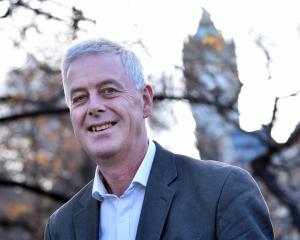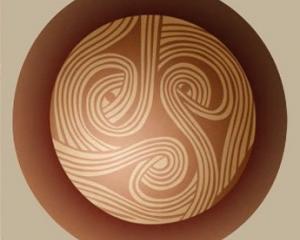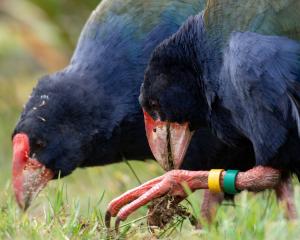There was little joy in spring, or any other season, for nature writer Richard Mabey during his long winter, as Adrian Haitians, of The Washington Post, reports.
At the fringe of his two-acre garden, Richard Mabey stops alongside an oak tree to point out a nesting box he put up for the barn owls.
He's seen owls in the adjoining field, and while they have yet to take up home in the oak tree, Mabey anticipates a day when they will.
This hope for the future, in itself, is a small triumph for one of Britain's best-known nature writers.
There was a time when there was no future for Mabey, not even a past, just a deep, numbing sense of despair induced by nothing in particular and everything in general.
His was a classic bout of profound depression, marked by days spent in bed with the curtains drawn against the very countryside that had shaped his life's work.
The breakdown cost him the family home where he had lived for 60 years, and three years of his life.
We know this, because Mabey did a most un-English thing: He told the world about it.
Nature Cure recounts the origins of his illness, its paralysing effects and how, moving from the wooded Catering Hills northwest of London to the bleaker coastal county of Norfolk, he began to right himself.
His account is not an emotion-fuelled catharsis funnelled into words, but a clear-eyed assessment of what happened and how a new environment as well as a new love helped Mabey to heal.
The naturalist, now 67, chose to examine the event in the same way that he had pondered the idea of swifts sleeping on the wing, or regional names for cherry trees, or the tufts of sedge grasses in the marshes.
"I wanted to view it through an ecological prism and look at it as a biological state," he says.
That journey of discovery, however, was made harder by the fact that melancholy has no raison d'être in biological terms.
Physical disease has a purpose - often it is caused by a pathogen that thrives on the sick.
But depression, he writes, "seems to have no connection with the biological business of living at all. And what it did to me was unearthly, in that it negated, cut dead, all the things in which I most believed: the importance of sensual engagement with the world, the link between feeling and intelligence, the inseparability of nature and culture".
Which brings us back to barn owls.
Perhaps his illness, he speculates in the book, is some sort of human version of a phenomenon seen in that saucer-eyed bird: Faced with peril, it faints.
This "vegetative retreat" offers a period of inward protection, and the owl awakes when the threat passes.
But for Mabey, the faint lasted from 1999 to 2001.
Today, frankly, it is difficult to think of Mabey as morose, or even 67.
He has a round and boyish face, essentially unlined and crowned with a mop of hair. He is chatty and given to smiles.
He lives in an idyllic setting, a 400-year-old cottage as organic as its surroundings, the walls made from the clay dug from the garden (leaving a duck pond) and crowned with a picture-postcard thatched roof.
There are an orchard, a walled vegetable garden, herbaceous borders and rose bowers.
A converted shed serves as a comfortable writer's lair.
Giving a tour, he shows where he uses a mower to nibble paths in and around a meadow "like an herbivore" and stops at a wooded corner of the meadow to lift two bell jars sheltering self-seeded bee orchids.
"Darwin thought they would become extinct. They're showing no signs whatever of becoming extinct," he muses.
He places the jar back over the orchid with the tenderness of someone who cares about his world once more.
Mabey's breakthrough book was his first - Food for Free - a guide to foraging that has sold half a million copies since it was first published in 1972 and is credited with helping to stir a modern interest in Britain's countryside.
In the 1980s, he wrote a biography of Gilbert White, the 18th-century naturalist and cleric whose The Natural History of Selbourne is considered the model for environmental writing.
A decade later, Mabey tackled his most ambitious book, Flora Britannica, in which he tells the social and cultural history of his country's native plants.
This followed the death of his mother, for whom he had been caring in the family home where he had lived almost all his life.
After Flora Britannica was published in 1996, Mabey found that, for the first time in his life, he had finished a book without ideas for others ready to fill the creative void.
He was, he says, "exhausted, played out" and he started to question the value of his work.
Moping developed into clinical depression, and he began receiving therapy, of which he later wrote: "The idea that discussing or simply understanding an illness will in some way make the hard-wiring that caused it disappear is, as most people who have been through it acknowledge, wishful thinking."
He tried repeatedly "to exorcise my depression" by immersing himself in the countryside "but all I felt was a kind of rebuke."
So he went to bed and closed the curtains, stirring only to drag himself to the pub to drown his sorrows.
He let the phone ring and the mail pile up, a tactic that brought debt collectors to the door.
In this fetal state, he formed "an escapist fantasy" of fleeing to the wilderness, living by his foraging skills.
"It was a ludicrous dream," he writes, "and mostly I just lay there, curled up in the 'crash position' they demonstrate to you on aircraft, scared stiff and praying hopelessly that the turbulence would pass."
On three occasions he checked himself into a psychiatric hospital, St Andrew's in Northampton.
This turned out to be the same institution where one of his literary heroes, the 19th-century nature poet John Clare, had been committed for the last 23 years of his life, after a diagnosis of lunacy caused by "years addicted to poetical prosing".
"I've left my own old home of homes," Clare wrote in a poem called "The Flitting," and Mabey recognised that feeling of displacement.
After his third hospitalisation, Mabey's doctors would only discharge him into the care of friends.
Thus he found himself living in a series of homes in Norfolk, a county marked by shingle beaches, intensive agriculture, low flat terrain and Dutch-style windmills.
His sister decided to sell the family home that had been his refuge - and, later, his dungeon - and he found himself adrift in the world.
But as that door closed, another opened. Mabey fell in love with an old acquaintance, Polly Munro.
And as she left to go on a previously planned vacation, she made a request that proved to be pivotal: She asked Mabey to keep a journal that she could read when she got back. He did.
He wrote about the garden, and the birds, and the wooded preserve he had created at his old family home, but he also wrote about events he attended and his political views and his days as an undergraduate in Oxford.
"The more I wrote," he tells readers, "the less my life seemed to resemble that of the marginalised voyeur I'd cast myself as."
By the time his sweetheart returned, "I realised I'd written what was virtually a short book, and that I had my life back again."
Over lunch in the village pub, Mabey says Nature Cure is a story of passage, from one physical place to another, from one emotional state to another.
The Catering Hills of his childhood are revered in England as a place of particular beauty, a hilly upland of hedgerows and meadows and woods and quaint villages.
His move to the flat, wet landscape of Norfolk put him in the middle of an entirely different environment that Mabey observes keenly.
He gives us wild horses and cranes and a marshland plant named hornwort, which actually fizzes with oxygen on hot days, singing like "Aeolian harps."
"I was having to learn to live in two ways which had not been available to me before, with a degree of independence that I hadn't had before and also - and this is where the nature bit comes in - the experience of getting ill and getting better," he says.
"It changed my perception of what writing was about."
Back in the garden of the home in Norfolk he and Munro have shared for the past five years, he points out a wildflower he has encouraged to grow amid the grass.
Hayrattle, it's called, and because it's semi-parasitic it stunts the grass and prevents it from taking over.
Mabey's new life and new work, including a sequel to Nature Cure, are his hayrattle, keeping the demons away.
He said he is "ever vigilant" against the melancholy returning.
"I think it unlikely because I have an infrastructure in my life I didn't have before. But I'm a moody person, I probably have as many bleak days as the next person, so I'm not complacent." - Adrian Haitians











